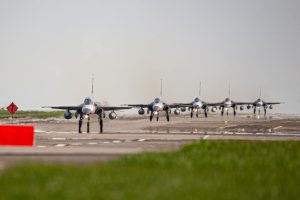The U.S. government has taken actions to tackle China’s stepped-up military pressure on Taiwan. On June 28, the U.S. House of Representatives approved an appropriations bill for the fiscal year 2025 that includes $500 million in Foreign Military Financing for Taiwan to strengthen military deterrence against China and up to $2 billion in loans and loan guarantees for the same purpose.
Two months prior, U.S. President Joe Biden signed into law a bill providing $95 billion in foreign aid to Ukraine, Israel, Taiwan, and other U.S. partners. Out of the $95 billion, $8 was dedicated to the Info-Pacific, including Taiwan.
A third example is the U.S. Senate Armed Services Committee’s release June 13 of an executive summary of the National Defense Authorization Act (NDAA) for Fiscal Year 2025 that asked the Pentagon to establish a “regional contingency stockpile” of arms for Taiwan.
However, delivery is key. On October 30, 2023, Taiwan’s then-Minister of National Defense Chiu Kuo-cheng stated that the U.S. government has postponed the delivery of weapons purchased by Taiwan. On June 16, 2024, incumbent Minister of National Defense Wellington Koo said that 1,700 TOW 2B anti-tank missiles Taiwan purchased – and that should have been delivered starting in 2022 – will all arrive by the end of this year.
History Repeats Itself
The current situation is similar to that of the early 1950s – the United States focused on the situation in Europe and could not help but postpone the delivery of weapons to Taiwan. At that time, the U.S. government adopted a “Europe First” policy in response to growing threats from the Soviet Union after the onset of the Cold War.
Seventy years have passed, but the situation in Europe is once again unstable due to the war in Ukraine. Supplying weapons to Ukraine has become the prime concern of Washington. Again, the United States is choosing to prioritize Europe over Taiwan.
The result, in both cases, is the delayed delivery of U.S. arms to Taiwan. In the 1950s, Republic of China (ROC) President Chiang Kai-shek believed that the United States would be willing to provide military assistance. U.S. President Harry Truman had set the tone of “letting the dust settle” after Chiang’s Nationalist government failed in military campaigns against the Chinese Communist Party and retreated to Taiwan in late 1949. U.S. Secretary of Defense George Marshall’s inquiries in February 1951 about the urgent needs of the Nationalist forces gave Chiang the perception that the U.S. government was once again willing to transfer arms.
Tardy arrival and insufficient supplies of U.S. munitions, therefore, infuriated Chiang. The arrival of U.S. arms was so belated that on January 10, 1953, Karl Rankin, then U.S. chargé d’affaires to the ROC, reported back to Washington that through the fourth quarter of 1952 only 30 percent of U.S.-promised materiel for 1951 and 1952 had been delivered.
A Worsening Situation
Even though the current situation is similar to that of 70 years ago, two differences are stark. First, the U.S. Seventh Fleet no longer patrols the Taiwan Strait.
Under an order from U.S. President Harry Truman on June 27, 1950 – two days after the onset of the Korean War – the mandate of the Seventh Fleet was to neutralize the potential for conflict in the Taiwan Strait. The Seventh Fleet’s task was to set up an invisible barrier in the Taiwan Strait to prevent the People’s Liberation Army (PLA) from attacking Taiwan and discourage the Nationalist forces of the ROC from counterattacking mainland China. The mandate was recalled before the Korean War ended. In other words, the Seventh Fleet helped protect the security of Taiwan throughout most of the duration of the Korean War when U.S. arms failed to be delivered as promised.
Second, Taiwan today faces an escalating clear and present danger from China like never before. Unlike China’s involvement in the Korean War, which postponed the PLA’s “liberation” of Taiwan, the eyes of China are solely on Taiwan nowadays. Three days after President Lai Ching-te took office on May 20, 2024, China conducted a two-day large-scale military exercise surrounding Taiwan. The PLA launched a similar drill after then-U.S. House Speaker Nancy Pelosi visited Taiwan on August 3, 2022.
Both exercises have one thing in common – the PLA chose to conduct military exercises in offshore areas of eastern Taiwan to prevent future foreign assistance coming from this direction.
On-Time Delivery Is Critical
An important implication for Taiwan is that the island will have to rely on its stockpiles of munitions after the onset of war in the Taiwan Strait, since foreign military assistance would be difficult, if not impossible, to arrive.
Taiwan’s situation is different from that of Ukraine. Even amid the Russian invasion, international military aid can still enter Ukraine via ground transportation. On the contrary, when the peripheries of Taiwan are under blockade by China, it will be difficult for foreign assistance or replenishments to be delivered, whether through maritime or aerial transport. At that time, Taiwan’s inventory will deplete fast.
War is attrition. A cross-strait war is going to witness consumption of munitions at an incredibly high speed. The PLA is most likely to complete military actions in a short time frame to reduce the likelihood of foreign intervention and/or military assistance to Taiwan. In response, Taiwan’s resistance and countermeasures will be on par with that of China.
The sooner the U.S. arms are delivered, the better the island could get prepared for a future war.
The scarcity of materiel 70 years ago in Taiwan was ameliorated over the period of 1951-53. Hopefully, it won’t take that long this time, especially since Taiwan no longer has the protection of the U.S. Seventh Fleet to rely on.
The United States has successfully protected Taiwan since 1950. Continued delayed deliveries of U.S. arms, however, would endanger Taiwan’s security and, in the meantime, bolster China’s ambition of invading the island.































